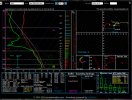While I have been personally less conservative for a while on tomorrow's threat - I think today's is a lot more balanced and on the margins, which in some ways makes it more interesting.
From the latest models, I'm (and I am just an amateur enthusiast so all this is based on self learned stuff and observations) seeing two main issues limiting today:
- The discrete mode is in my opinion somewhat conditional and isnt necessarily perfectly supported by the background synoptic or a nicely defined boundary. Not to say we wont see discrete storms evolving across SE OK later but I just find it harder to confidently say an intense tornado risk is present when we don't yet know about a long duration discrete mode in the same timeframe as when wind profiles improve later on. The mode will almost certainly be discrete initially with a massive hail risk, but shear will be much less favorable for strong tornadoes during this period. The opposition to that is that CAMS have been showing a pretty solid signal for a while now - this is quite hard to ignore
- I think the environment around the discrete cells could be a bit too dry. Storms will entrain a lot of dry air, will easily become outflow dominant and also have trouble producing intense tornadoes with such a cool/unbuoyant RFD if the storm ingests air as dry as this sounding suggests (taken SE from the Oklahoma discrete storm at 01z). That could also play into limiting the discrete mode as mentioned above. However, what's interesting is that proximity soundings which are contaminated but closer to the storm have a much more moist boundary layer - but its hard to draw the line of what is a realistic storm scale environmental modification which the storm would produce in the model as opposed to real life.
With those two caveats gone, the environment across SE Oklahoma after 00z does look to turn very favorable especially with regards to the enlarged hodographs. If we still have a discrete cell that can balance the various updrafts and downdrafts well enough, I think it’s a distinct possibility that an intense tornado could be produced. This is definitely a good scenario I could envisage the SPC using the 'double hatched' in the future: in one or two places things could become very bad - but the uncertainty of this is very high and I can understand them not wanting to upgrade to 15% at this point going on uncertainty and coverage issues.









